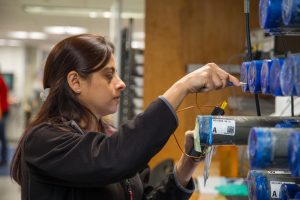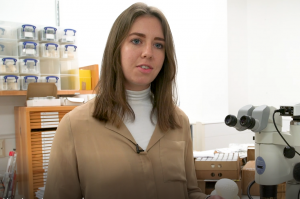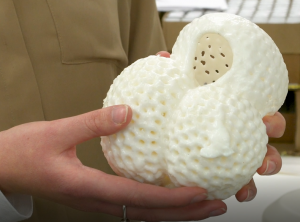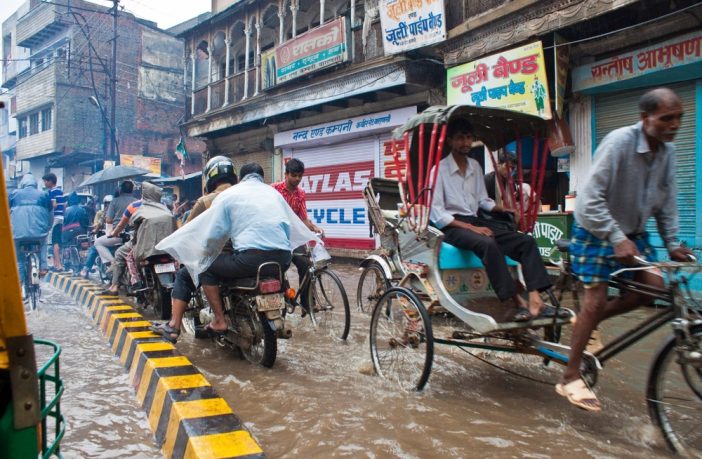A study by an international research team led by The Open University (OU) has revealed new insights to help understand the historical importance of the Indian Summer Monsoon. The study shows how the Monsoon acted as a conduit for moving heat and moisture during a period of climate transition, thousands of years ago.
• Study shows fresh evidence of how the Indian Summer Monsoon behaved as a result of climate change thousands of years ago.
• Results showed how Monsoon was a gateway for transporting heat and moisture in the past
• Marine sediment, taken from an expedition to the Bay of Bengal was analysed over several months in OU labs
• Study found new tool for reconstructing Monsoon activity in the past
• With existing data, it will help climate change scientists understand what could happen in the future.

Dr Anand measuring on board the drilling vessel
The study, led by the OU’s Dr Pallavi Anand with research carried out and co-written by PhD student Katrina Nilsson-Kerr, is the first to be published following an International Ocean Drilling Programme (IODP) voyage to the Bay of Bengal in 2014 to better understand past variability of the Indian Monsoon.
The paper, Role of Asian summer monsoon subsystems in the inter-hemispheric progression of deglaciation, is published in Nature Geoscience (18th March 2019). The annual Indian Summer Monsoon represents one of Earth’s most dynamic interactions of ocean-atmosphere-terrestrial processes, affecting some of the globe’s most densely populated regions.
“Critical to gain understanding of Indian Summer Monsoon”
Their study enabled a reconstruction of how the Indian Summer Monsoon responded to a change to a warm, interglacial period around 128 thousand years ago from a cold glacial interval around 140 thousand years ago. The study involved examining sediments recovered from the northern Bay of Bengal, fed by river runoff sourced from the Ganges-Brahmaputra river system.
Dr Anand said:
Understanding the response of the Indian Summer Monsoon to human-induced climate change remains unknown. Therefore, it is critical to gain a comprehensive understanding of how the Indian Summer Monsoon responded to climatic changes in the geologic past, in order to better inform climate models used for predicting its future response.
Putting their newly-generated records in context with existing published climate data, she said the study reveals the Indian Summer Monsoon as an “incredibly dynamic system” which responds to changes in climate in both the northern and southern hemisphere.

Katrina Nilsson-Kerr, PhD student who worked in the OU labs
Samples of marine sediment retrieved for this study were ideally situated to capture past changes in the strength of the Monsoon, possessing the mix of elements which results during the Summer Monsoon, when rainfall feeds the rivers draining into the Bay of Bengal, promoting freshening of seawaters and delivery of continental material.
Team examined chemical make-up of microfossils
In order to reconstruct how the Indian Summer Monsoon behaved in the past, the research team looked at the chemical composition of tiny microfossils (foraminifera), preserved in the marine sediment.
Their study revealed the potential for certain chemical elements preserved in the shell of the foraminifera to reconstruct the strength of river runoff in the past. Their study was also unique as it provided a high temporal resolution (i.e. each sample representing 250 years in contrast to 1,000 years as has been done previously) snapshot of how the monsoon responded to warming during the penultimate deglaciation.

Katrina shows a 3d impression of a foraminifera microfossil.
Put in context with existing published climate data, the research team’s records show how the Monsoon helped spread warmth and moisture between the southern hemisphere and the northern hemisphere, and thereby promoted global deglaciation (a move from the ice age to a period of warmer climate).
Katrina said:
Examining this sediment is so important because when we want to look at the future behaviour of the monsoon, in terms of how human induced climate change will affect it, we look at historical patterns to get an underpinning of how our understanding from the past could help inform us regarding its future behaviour.
Dr Anand was one of two UK representatives to earn a place to sail on an international research vessel through IODP Expedition 353 that set off in 2014 to retrieve deep-sea sediments capturing monsoon variability by drilling the seabed of the Bay of Bengal. This expedition was made possible due to Indian’s involvement in the IODP, allowing the first international drilling to occur north of 9º and in locations close to river runoff, ideal for investigating past monsoon rainfall.
Next steps will explore situation in a modern environment
The samples were carefully selected – which Katrina examined in the OU’s geochemistry labs during the course of her PhD. This project also included collaboration from the OU (Drs S Hammond and P.F. Sexton), British Geological Survey (Prof. M. Leng), Brown University (Prof. S. C. Clemens) and Indian Institute of Science, India (Dr. S. Misra).
The next steps are to investigate the Indian Summer Monsoon response during the warm climate states and further explore the new chemical tool of river runoff in the modern environment. Further studies, at high temporal resolution, are needed to strengthen our knowledge of how Indian Summer Monsoon rainfall responded to different climate states. The new direction of research in shell bound chemical runoff tool, found in this study, will be required to quantify it in the modern environment for its wider applicability.



